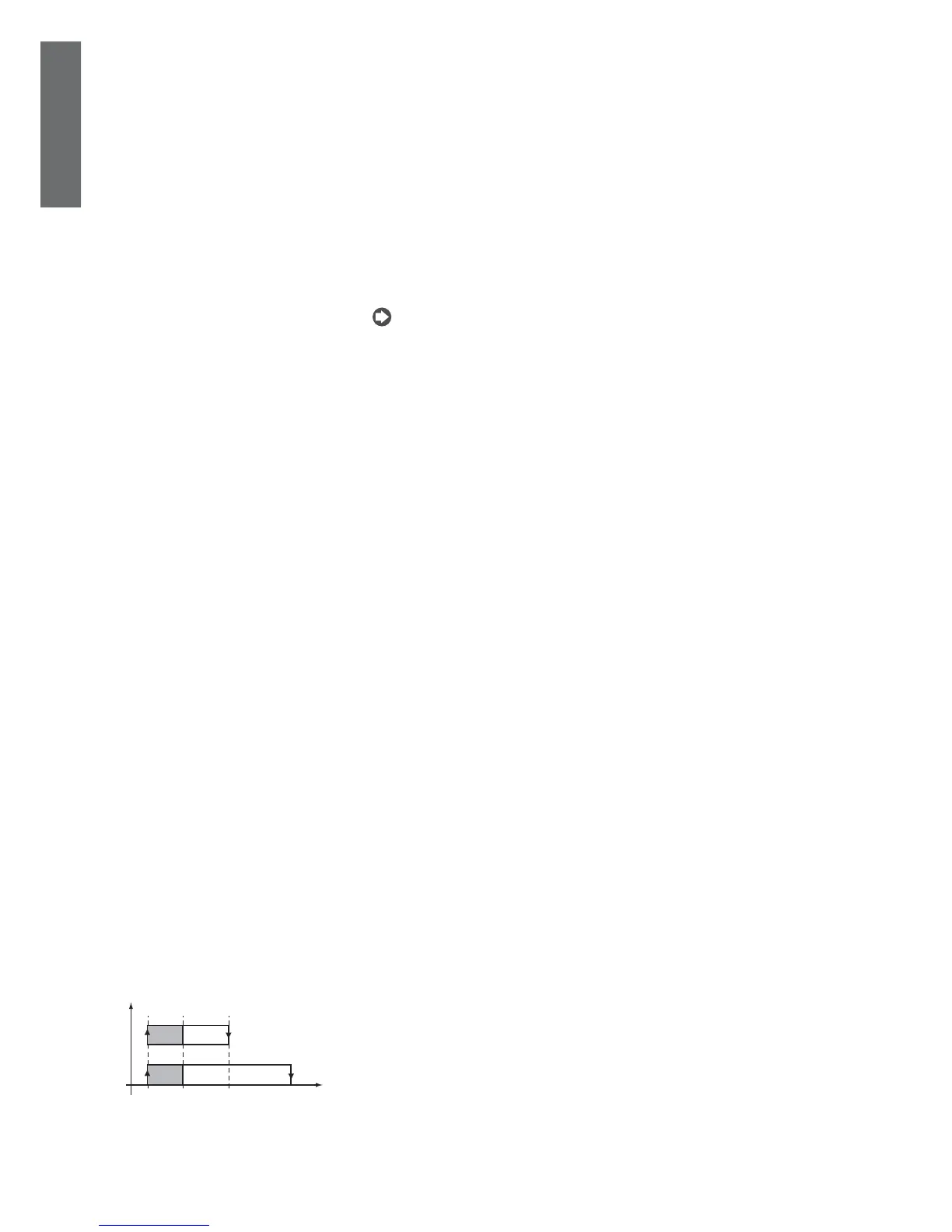48
1 bar 1,5 bar 2 bar F08-F09
ENGLISH
µC
2
SE - +030220426 - rel. 2.0 - 03.08.2009
- Function of the second pump
H21: This parameter defi nes how the output dedicated to the second pump must be managed.
H21= 0: the second pump is disabled.
H21= 1: the second pump is used only as a backup.
If the fl ow switch and corresponding alarm are activated, the pumps are switched over:
if the alarm passes, a warning is shown on the display and the warning relay is activated, while the •
unit continues to operate with the Backup pump. When the next alarm is activated the pumps will be
switched over.
if the alarm remains active even with the second pump on for longer than the time set for P1, the •
generic alarm is generated and the unit is switched OFF.
H21= 2: the second pump represents a backup pump. The two pumps are never used at the same time
but each 24 hours, are switched over. In the event of fl ow alarms, the logic is the same as for setting 1.
After being switched over due to the fl ow alarm, the 24-hour timer is set to zero.
H21= 3: the second pump is used as an ON/OFF device in the same way as the condenser fan (which in
this case is not present), in ON/OFF mode, with the same settings (in fact in this case the pump replaces
the fan, including the symbol).
H21= 4: the second pump is used for the condenser but is always ON. In this case the pump symbol is
not managed.
Note: In the event of fl ow alarms with automatic reset, 10 attempts are made to restart the pump every
90 seconds, for a maximum time of P02; after the 10 attempts, the alarm becomes manual reset. With the
second pump, the attempt consists in switching over the pump that is on, with the same logic.
- Disable load default values
H22: If this parameter is set to 1, it disables the possibility of restoring the default parameters using the
PRG button at power ON.
- select supervisor protocol
H23: establishes the protocol used for the connection to the supervisor from the serial board RS485
H23 = 0: CAREL protocol (baud rate 19200,…)
H23 = 1: Modbus protocol
• Alarm settings: parameters (P*)
- Flow switch alarm delay when starting pump
P01: Establishes a delay in the recognition of the fl ow switch alarm when starting the pump (this allows
the fl ow-rate to stabilise). In the event of alarms, the compressors are stopped immediately, ignoring the
times.
- Flow switch alarm delay in steady operation
P02: Establishes a delay in the recognition of the fl ow switch alarm in steady operation, so as to fi lter any
variations in fl ow-rate or air bubbles present in the water circuit. In the event of alarms, the compressors
are stopped immediately, ignoring the times.
- Low pressure alarm delay at compressor start
P03: Establishes a delay in the recognition of the low pressure alarm when the compressor starts, so as
to allow stable operating conditions to be reached. This delay is also counted when reversing the 4-way
valve in the refrigerant circuit.
- Part load in high pressure and low pressure in heat pump
P04: enable or disable the part load operation of the circuit in high pressure.
The function is valid if the unit is fi tted with tandem or capacity controlled compressors and pressure
transducers. In the event of high pressure alarms, that is, for values over P18 (hysteresis 0.5 bar), the
controller deactivates a load step in the circuit in question and waits 10 seconds. After this interval, if
the alarm is still active, the unit is stopped, otherwise it continues to operate in part load mode. In this
situation, the display shows the message PH1 and/or PH2, depending on the circuit. This condition
remains active until the pressure falls below the value corresponding to the maximum speed of the
condenser fans (F05+F06). Below this value, the unit reactivates the load step that had previously been
deactivated.
P04=0: capacity control not activated
P04=1: capacity control activated for high pressure
P04=2: capacity control activated for low pressure
P04=3: capacity control activated for high and low pressure
With the unit operating in heat pump mode, due to low outside temperatures or the load the pressure
may fall and stop the unit due to the low pressure alarm. If the circuit has 2 compressor steps and
the pressure remains below the value of one bar for the time P22, the circuit can operate at part load.
This capacity control is not activated when the alarm comes from the digital input. In the event of low
pressure, the controller deactivates one step and if the pressure does not return above the threshold in 10
seconds, the alarm is activated and the circuit is stopped. This function is valid for all units with pressure
transducers.
Fig. 5.b.b
all LP
pressure
Part load in low pressure
parz LP

